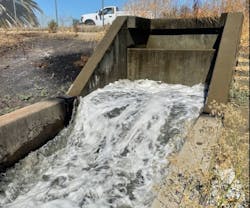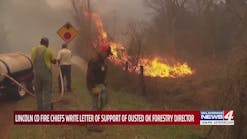CA FFs Turn to Flooding to Stop Stubborn Wildfire
By Jill Tucker
Source San Francisco Chronicle (TNS)
Jul. 18—After seven weeks of failed attempts to stop a marshland blaze near Pittsburg with traditional land and air tactics, fire officials have switched to an unconventional, flood-the-zone tactic, using 1.2 million gallons of water every hour to finally put out the flames.
The Contra Costa Water District started diverting water from the Mallard Slough area starting Saturday afternoon to douse the Marsh Fire, which has burned through decayed peat and other vegetation since it ignited on May 28 at a homeless encampment.
The property owner of the burning property also brought in large pumps over the weekend to increase the flow, said Steve Hill, spokesman for the Contra Costa Fire Protection District.
It could take up to a week to fully flood the area and put the fire out, Hill said, although the 60 million gallons already poured into the area seemed to be working.
"We want to get the water there as quickly as we can," he said. "It seems as though we're getting some effect."
1.2 million gallons, the amount poured on the fire per hour, is equivalent to two Olympic-sized swimming pools, or the amount of water 25,000 Californians would use in a day.
Officials acknowledged that the flooding option raised environmental concerns, especially given the drought, and required approvals from multiple agencies, but it appeared to be the only option left.
"We had tried all the more conventional methods of extinguishing that fire," Hill said. "It just proved to be ineffective."
The fire has burned through more than 500 acres of decomposing peat and brush in an area with unstable soil, where fire trucks could sink or fall into holes where the fire is burning beneath the grass.
It's not unusual for wetlands fires to burn for weeks or months. Dropping water from the air — or waiting it out — were the only options available.
While the fire had been burning for weeks, heat and winds kicked up the flames and spread just over a week ago pushing more smoke into neighboring communities and forcing fire officials to launch an attack from the air.
"On Monday and Tuesday, we dumped about 400,000 gallons of water — one 660-gallon bucket at a time — on the fire, and it had little to no effect," Hill said. "That serves to show the challenge we face."
The fire at one point threatened overhead PG&E power lines and neared decommissioned industrial plants, including a former power plant that is owned by GenOn.
Waiting it out was no longer an option, and flooding was the last resort, Hill said.
Fire officials said last week they were working on the approval for the flooding option, a bureaucratic battle that involved the Environmental Protection Agency, the U.S. Army Corps of Engineers, Regional Water Quality Control Board and the local mosquito abatement district, and probably others, Hill said.
With smelly smoke continuing to push its way across the region, prompting air quality advisories for Pittsburg, Antioch, Oakley and Brentwood, and after permission was granted, they lined up the pumps and opened the gates to flood the region.
Officials said they were diverting water from the Delta and Contra Costa Water District.
Staff writer Michael Cabanatuan contributed to this story.
Jill Tucker is a San Francisco Chronicle staff writer. Email: [email protected] Twitter: @jilltucker
___
(c)2022 the San Francisco Chronicle
Visit the San Francisco Chronicle at www.sfchronicle.com
Distributed by Tribune Content Agency, LLC.






